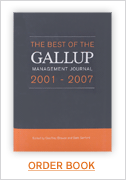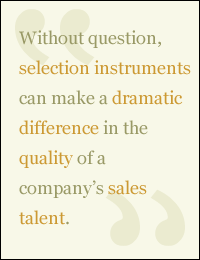More than 800,000 people have taken StrengthsFinder, Gallup's Web-based talent assessment. Since the publication of Discover Your Sales Strengths, this trend has been increasing. More and more sales professionals are learning how they can improve their sales performance and increase customer engagement by harnessing the power of their talents. Nothing could make us happier. Helping salespeople improve their performance was the whole reason we wrote Discover Your Sales Strengths in the first place.
 |
Recently though, we have been fielding a substantial number of questions from senior sales executives about using StrengthsFinder as a tool to help evaluate sales applicants. Not long ago, a vice president of sales for a large financial institution said to us: "I've noticed that some of my best performers seem to have themes like Achiever, Self-Assurance, Command, Positivity, Relator, or Responsibility. Would it help my organization to use StrengthsFinder to screen candidates, and then hire individuals who had those same themes?"
Broadly speaking, this executive was asking us two separate questions. The first question is: Is it a good idea to try to hire people who have talents similar to your best producers? The answer: absolutely. The second question is: Is StrengthsFinder a good instrument to use to make that determination? The answer: absolutely not.
Drawing on more than 30 years of extensive research, Gallup works with companies in two connected yet distinct ways to help them improve their business performance. First, we show businesses how to hire employees whose talents indicate great potential in particular roles. Second, we show organizations how to develop strengths by building on the talents of their existing employees. The connection -- talent -- is obvious, and it is the common starting point for our selection and development assessment tools. But the outcomes are different, so we use different tools to achieve them.
Using talent to select a new hire
Selection instruments are designed for a very narrow purpose: to help a company make better hiring decisions. These instruments are developed by carefully examining a company's best performers. If a company had a sales force of 1,000 people, we would look at the 100 best performers. We would compare them to a contrast group of another 100 people. Our research team would then look for questions that the best performers consistently answer differently from the comparison group. Eventually, we will isolate the set of items that produces a marked contrast in responses between the two groups. These questions become the basis for a selection instrument. Gallup is able to make a prediction about the likelihood of new applicants' success in their roles based on how they answer this set of items.
The questions used in these assessments -- and the answers -- tend to be unique, even when the jobs may seem similar. Recently, Gallup developed selection instruments for two different companies in the mortgage brokerage business. Each selection instrument contained approximately 50 items, yet there were only four items that were the same on both assessments.
To be as accurate as possible, selection instruments include questions that have proven to be predictive of success for a particular job within a specific company. This is because the goal of a selection instrument is to make as accurate a prediction as possible regarding an applicant's likely success in that role. If a selection instrument is well-designed, the higher that applicants score on an assessment, the more likely they are to produce at a high level for that role.
After an instrument is developed, the next step is to validate the process. Does the instrument really work the way it is supposed to? The first way to answer this is through a concurrent validity study. We go back into the same sales force and interview a number of people. Our aim is to confirm that those who scored higher on the selection instrument are actually better performers than those who didn't score as high. If this test is successful, we know there is a good correlation between performance and assessment results.
 |
As the instrument is rolled out and used as part of the selection process, we conduct additional, "predictive validation" studies. When an applicant gets a high score on the assessment and is hired, we track his or her performance to make sure there is a correlation between the score and how well that person performs in the role. Again, if a selection instrument has been well-designed, the best performers will score higher on the selection instrument than lower performers. Eventually, most companies choose to hire only those sales representatives with high scores on their assessments. This validation process is also essential to make sure that the selection instruments can successfully meet any legal challenge.
Without question, selection instruments can make a dramatic difference in the quality of sales talent a company brings into the organization. It is not surprising that interest in well-designed selection instruments for salespeople is growing rapidly.
Developing a salesperson's talents
A development-oriented assessment such as StrengthsFinder is markedly different from selection tools because its purpose is not to assess whether an individual is suited for a particular job or role. Instead, it aims to provide talent insights for developing strengths within roles.
Selection instruments are predictive of a person's success in a specific job, but they don't tell us the best way for an individual to perform that job. Two applicants might have an identical score on a selection assessment, but the way they're inclined to do their jobs may be very different. This is where a tool like StrengthsFinder becomes valuable; by understanding their dominant talents, individuals can build strengths that allow them to do their jobs much more productively.
Just as the purposes of selection instruments and development assessments are different, so are the methodologies used to design these instruments. For example, selection instruments use different questions for almost every job. StrengthsFinder, on the other hand, presents the same 180 pairs of statements to everyone. Selection tools provide only a predictive score as an end product. But StrengthsFinder gives much more feedback. It provides the names of actual themes that people can use as a starting point in discovering their talents. And, after years of providing feedback to individuals, Gallup is able to provide considerable information as to how those talents can serve as the basis of strength -- the ability to provide consistent, near-perfect performance in a given activity.
If you're trying to get better at something like sales, it's very helpful to know how you're most naturally able to build trust with a customer, to ask for the order, to present information, and to organize your work. Understanding these characteristics about yourself will help you optimize your results by making the most of your dominant talents.
We have found that when sales representatives develop a talent-based sales approach, they significantly increase their percentages of engaged customers. When sales representatives build their sales styles on their dominant talents, their approaches to customers become much more authentic, and the relationships that develop between the customers and the company are much more solid.
 |
What if you have two people who take StrengthsFinder, and they have exactly the same top five themes? If one of those individuals is an excellent salesperson, doesn't that mean that the second individual would also be an excellent salesperson for that same company? The answer, surprisingly, is not necessarily. Predictive success in a job doesn't depend on just a person's top themes. Great variation exists in the specific talents -- and in the intensity of those talents -- within those themes. Themes are only a starting point. That's another reason why StrengthsFinder is an excellent development tool, but not a selection tool.
All about talent
In very real ways, talent is a part of both the selection and development processes. Understanding a person's talents guides employers in making better hiring decisions and helps them bring people who can perform at exceptional levels into the organization. Understanding talents can also help employees refine the way they do their jobs and considerably enhance their performance.
If you are running a sales organization, you should know the answers to two questions: Is the candidate I am thinking about hiring likely to be as good as my very best people? And then, If I hire this person, how can I get the most out of his or her talents? A good selection instrument designed for a particular sales role can help answer the first question. A good development assessment, such as StrengthsFinder, can help answer the second.